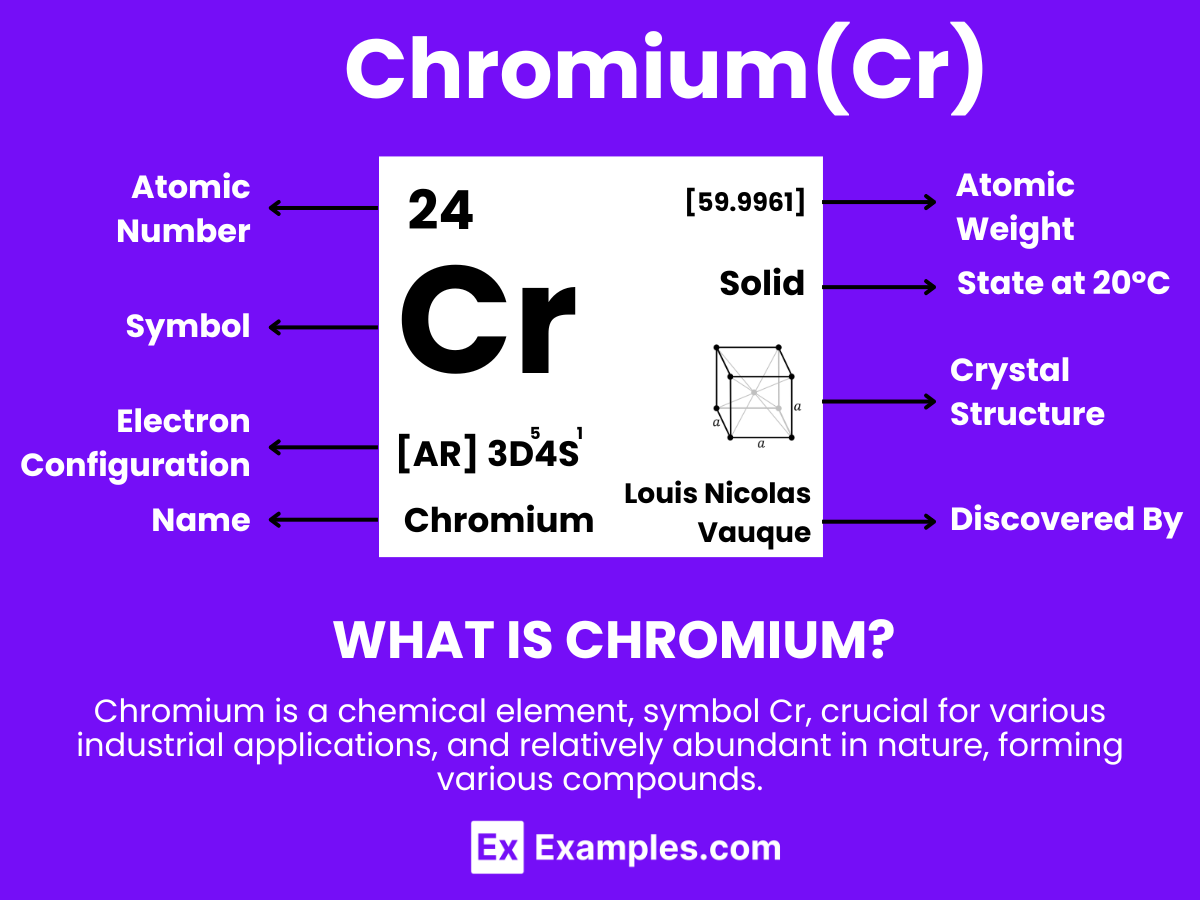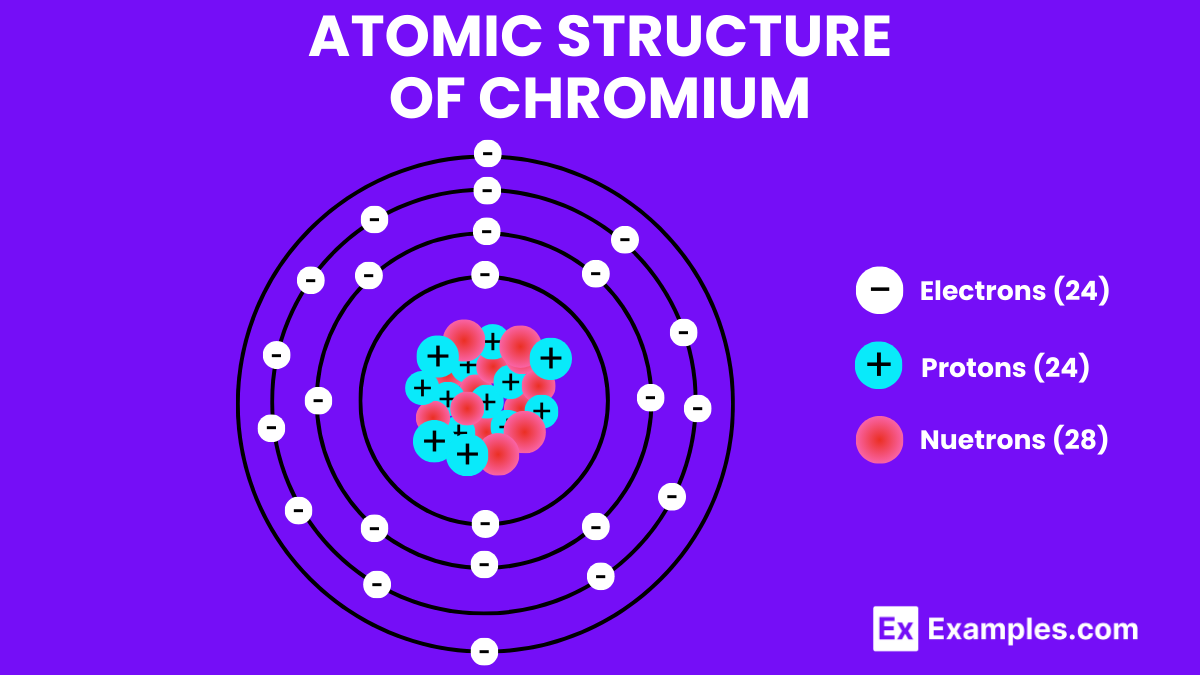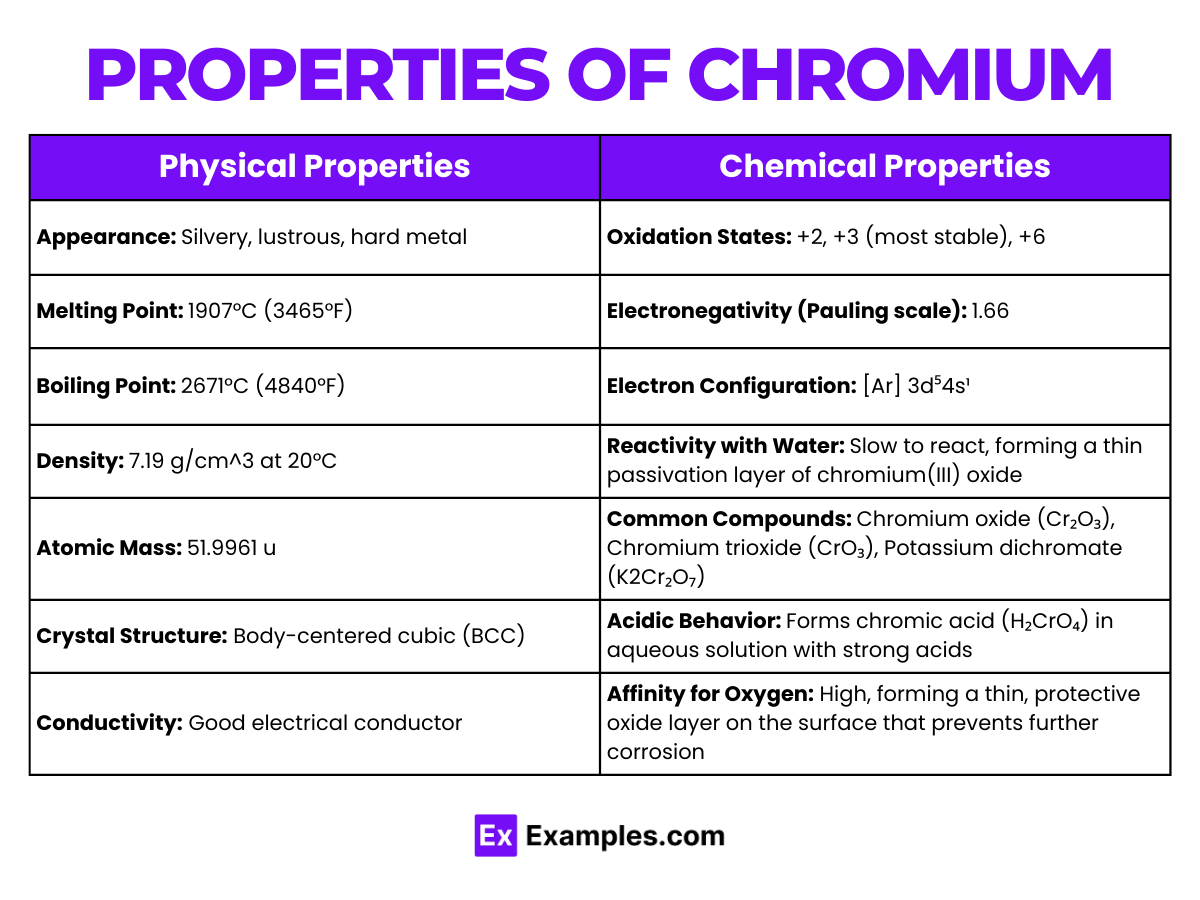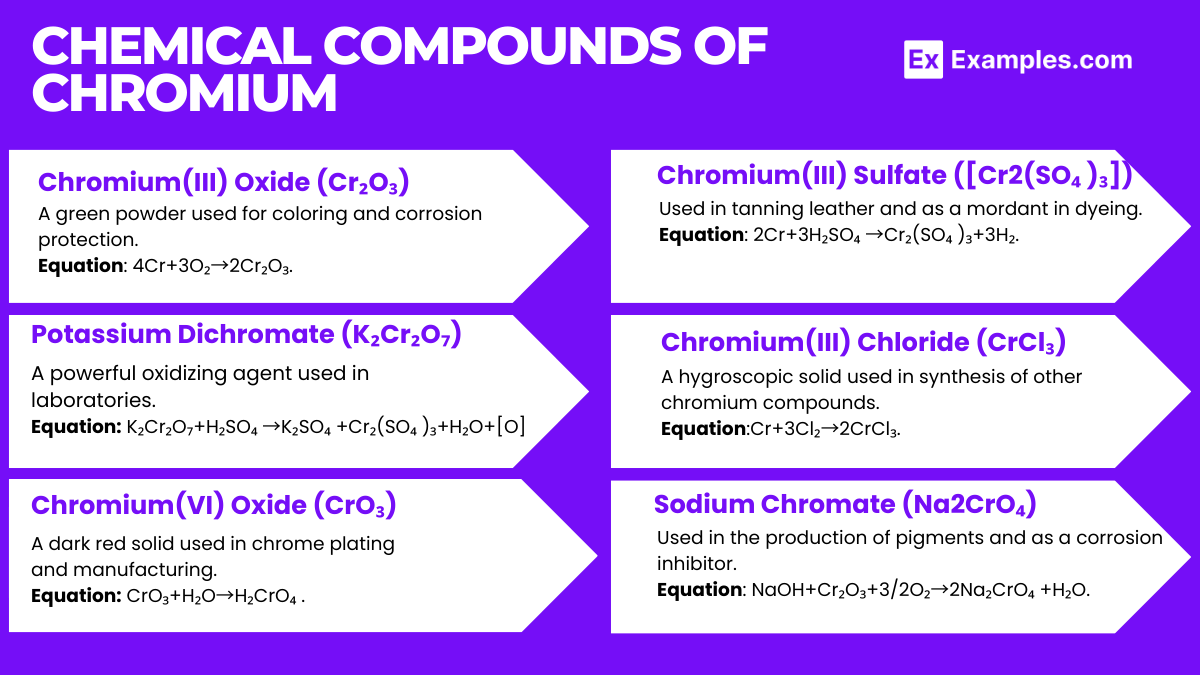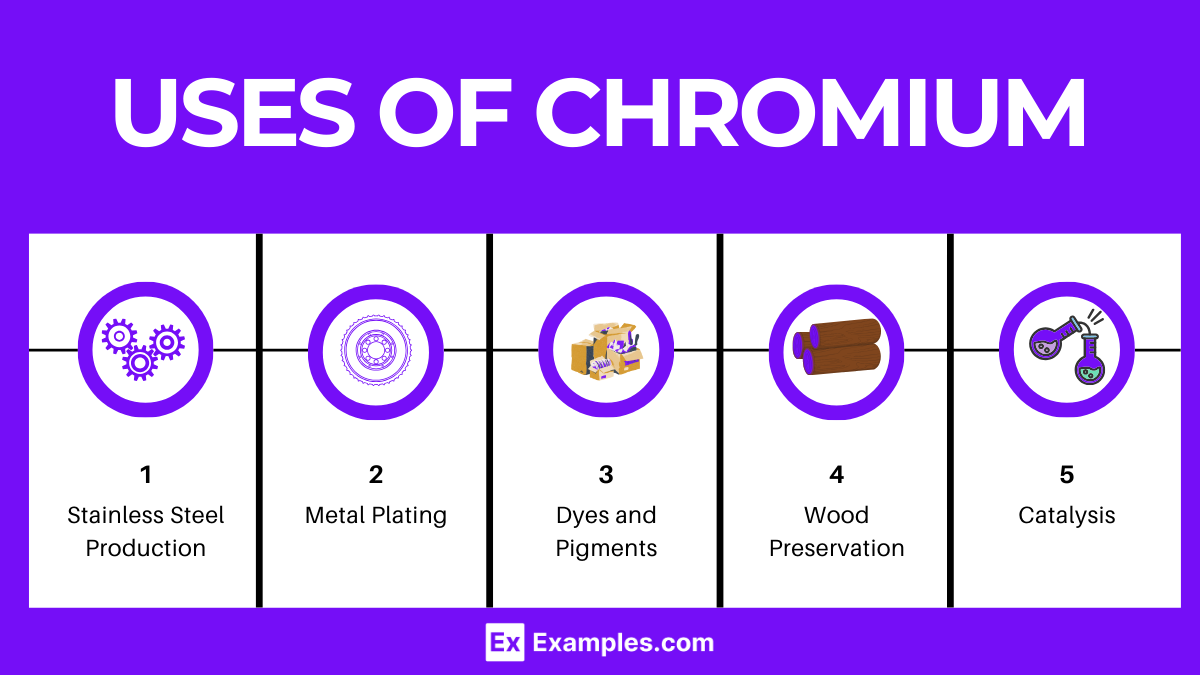Chromium
Chromium, a lustrous, steely-gray metal, plays a pivotal role in both health and technological advancements. This guide delves into the multifaceted uses and benefits of chromium, from its essential contribution to metabolic processes in the human body to its critical application in manufacturing and industrial sectors. With a focus on how chromium enhances the durability of materials and supports nutritional well-being, we explore its significance in daily life and innovative technologies. Through detailed examples, this article sheds light on chromium’s indispensable presence in our modern world.
What is Chromium?
Chromium is a lustrous, steel-gray metal that stands out for its durability and shiny appearance. Holding the atomic number 24. chromium is renowned for its high corrosion resistance and hardness. This metal is not found freely in nature but is primarily extracted from the mineral chromite. Chromium is extensively utilized across numerous industries, owing to its versatile properties. It plays a crucial role in the manufacturing sector, especially in metal plating and as an important component in stainless steel, enhancing its corrosion resistance. Additionally, chromium is used in the production of dyes and pigments, given its vibrant and various colors when combined with other elements. Its application extends to the leather tanning industry as well, where it is used to produce durable and resistant leather products
Chromium Formula
- Formula: Cr
- Composition: Consists of a single chromium atom.
- Bond Type: In its elemental form, chromium does not have bonds as it is a pure element. However, chromium can form covalent or ionic bonds when reacting with other elements.
- Molecular Structure: As a pure element, chromium does not form a molecular structure in the same sense as compounds like H₂O. At room temperature, chromium is in a metallic state with a bcc (body-centered cubic) crystalline structure.
- Electron Sharing: In compounds, chromium typically shares electrons covalently or transfers electrons ionically, depending on the nature of the other element(s) it is bonding with.
- Significance: Chromium is notable for its high corrosion resistance and ability to impart a shiny finish, making it essential in stainless steel production, chrome plating, and various alloys. Its durability and aesthetic qualities are invaluable in automotive, construction, and manufacturing industries.
- Role in Chemistry: Chromium plays a significant role in industrial processes, especially in metallurgy and electroplating. Its compounds are vital for dye and pigment production, wood preservation, and leather tanning, marking it as a crucial material in various technological and chemical applications.
Atomic Structure of Chromium
Overview
- Chromium, with the symbol Cr, is the 24th element on the periodic table.
- It showcases unique properties that stem from its complex atomic structure.
Atomic Number
- The atomic number of chromium is 24, indicating it has 24 protons in its nucleus.
Electron Configuration
- Electrons in chromium are arranged in the configuration [Ar] 3d⁵4s¹.
- This configuration is essential for chromium’s chemical behavior and properties.
Resistance and Oxidation States
- Chromium’s electron arrangement contributes to its high resistance to corrosion.
- It can exhibit various oxidation states, from -2 to +6, with +3 and +6 being the most prevalent.
- These states are crucial for its diverse applications in industries.
Applications
- The unique atomic structure allows chromium to be used in stainless steel production, pigments, and electroplating.
- Chromium’s interactions with other elements make it indispensable in many industrial processes
Properties of Chromium
Physical Properties of Chromium
| Property | Value |
|---|---|
| Appearance | Lustrous, steel-gray metal |
| Atomic Number | 24 |
| Atomic Weight | 51.9961 |
| Density | 7.15 g/cm³ at 20°C |
| Melting Point | 1907°C (3465°F) |
| Boiling Point | 2671°C (4840°F) |
| State at 20 °C | Solid |
| Electrical Conductivity | Good, but less than copper |
| Thermal Conductivity | 93.9 W/(m·K) at 25°C |
| Heat of Fusion | 21.0 kJ/mol |
| Heat of Vaporization | 347 kJ/mol |
| Specific Heat Capacity | 0.449 J/g·K at 25°C |
| Electronegativity | 1.66 (Pauling scale) |
| Crystal Structure | Body-centered cubic (bcc) |
Chemical Properties of Chromium
Chromium, a transition metal with the symbol Cr and atomic number 24, exhibits a wide array of chemical properties owing to its position in the periodic table. This element is known for its remarkable resistance to tarnishing and high melting point, characteristics that make it invaluable across various industrial applications.
Oxidation States
Chromium displays a variety of oxidation states, ranging from -2 to +6, with +3 (Cr^3+) and +6 (Cr^6+) being the most stable and common. These varied oxidation states allow chromium to form a diverse range of compounds, reflecting its versatile chemistry.
- Chromium(III) Oxide: When chromium reacts with oxygen, one of the compounds it forms is chromium(III) oxide. The equation for this reaction is:
- Chromium(VI) Oxide: Another significant compound is chromium(VI) oxide, which demonstrates chromium in its +6 oxidation state. This compound is produced through the reaction of chromium(III) oxide with oxygen under alkaline conditions: 4 Cr₂O₃+3 O₂→2 CrO₃
Corrosion Resistance
One of chromium’s most notable chemical properties is its exceptional resistance to corrosion. This is largely due to the formation of a thin, protective oxide layer on the surface when exposed to oxygen. This layer, primarily consisting of chromium(III) oxide (Cr₂O₃), acts as a barrier that prevents further oxidation of the underlying metal.
Reaction with Acids
Chromium reacts with acids to form chromium salts and hydrogen gas, showcasing its reactivity with different chemical reagents. For example, when chromium reacts with hydrochloric acid, the reaction yields chromium(III) chloride and hydrogen:
2 Cr+6 HCl→2 CrCl₃+3 H₂
Reaction with Bases
In the presence of bases and oxidizing agents, chromium can form chromate and dichromate ions, which are in the +6 oxidation state. For instance, when chromium(III) oxide reacts with sodium carbonate in the presence of oxygen, sodium chromate is formed:
2 Cr₂O₃+4 Na₂CO₃+3 O₂→4 Na₂CrO₄+4 CO₂
Environmental Impact
Chromium compounds, especially those in the hexavalent state are toxic and have significant environmental and health impacts. Chromium(VI) compounds, such as chromium trioxide and various chromates, are powerful oxidizing agents and are carcinogenic. Proper handling and disposal practices are essential to mitigate their adverse effects.
Thermodynamic Properties of Chromium
| Property | Value |
|---|---|
| Melting Point | 1907 °C |
| Boiling Point | 2671 °C |
| Heat of Fusion | 21.0 kJ/mol |
| Heat of Vaporization | 347 kJ/mol |
| Specific Heat Capacity | 0.449 J/g·K |
| Thermal Conductivity | 93.9 W/m·K |
| Thermal Expansion | 4.9 µm/m·K (at 25 °C) |
Material Properties of Chromium
| Property | Value |
|---|---|
| Density | 7.19 g/cm^3 |
| Mohs Hardness | 8.5 |
| Young’s Modulus | 279 GPa |
| Tensile Strength | 282 MPa |
| Brinell Hardness | 687 HB |
| Poisson’s Ratio | 0.21 |
Electromagnetic Properties of Chromium
| Property | Value |
|---|---|
| Electrical Resistivity | 125 nΩ·m (at 20 °C) |
| Magnetic Ordering | Antiferromagnetic (below 311 K) |
| Magnetic Susceptibility | -98.6·10^-6 cm^3/mol (at 298 K) |
Nuclear Properties of Chromium
| Property | Value |
|---|---|
| Natural Isotopes | ^50Cr, ^52Cr, ^53Cr, ^54Cr |
| Isotope Abundance | ^50Cr (4.345%), ^52Cr (83.789%), ^53Cr (9.501%), ^54Cr (2.365%) |
| Atomic Mass | 51.9961 u |
| Cross Section | 18.1 barns (for ^52Cr, thermal neutrons) |
| Half-Life | Stable (most isotopes) |
Preparation of Chromium
The preparation of chromium involves several key steps to extract it from its ores and refine it into a usable form. The most common ore of chromium is chromite (FeCr₂O₄ ), from which chromium is extracted through various processes. Here is an overview of the primary methods used in the preparation of chromium:
- Mining and Concentrating: Chromite ore is mined and then concentrated through gravity and magnetic separation techniques to increase the chromium content.
- Metallurgical Processes:
- Smelting: The concentrated ore is then smelted in an electric arc furnace or a blast furnace, where it is mixed with carbon (coke) and a flux (like limestone). In the electric arc furnace, high temperatures lead to the reduction of chromite to produce ferrochrome, an alloy of iron and chromium.
- Aluminothermic Process: This is an alternative process where chromium oxide (Cr₂O₃) is mixed with aluminum powder and ignited. The exothermic reaction reduces the chromium oxide to chromium metal, releasing aluminum oxide as a byproduct.
- Refining: The crude chromium obtained from the smelting or aluminothermic process is refined to improve its purity. This can be achieved through various methods, including:
- Electrolytic Refining: Chromium is dissolved in an electrolyte and then deposited on a cathode to produce high-purity chromium metal.
- Vacuum Degassing: This process involves heating the chromium in a vacuum to remove volatile impurities.
- Final Processing: The refined chromium is then processed into various forms, such as flakes, powder, or ingots, depending on its intended use. This may involve additional steps like crushing, grinding, and packaging.
Chemical Compounds of Chromium
- Chromium(III) Oxide (Cr₂O₃): A green powder used for coloring and corrosion protection. Equation: .
- Potassium Dichromate (K₂Cr₂O₇): A powerful oxidizing agent used in laboratories.
Equation: . - Chromium(VI) Oxide (CrO₃): A dark red solid used in chrome plating and manufacturing. Equation: .
- Chromium(III) Sulfate ([Cr2(SO₄ )₃]): Used in tanning leather and as a mordant in dyeing. Equation: .
- Chromium(III) Chloride (CrCl₃): A hygroscopic solid used in synthesis of other chromium compounds.
Equation: . - Sodium Chromate (Na2CrO₄): Used in the production of pigments and as a corrosion inhibitor.
Equation: .
Isotopes of Chromium
Chromium has several isotopes, both stable and radioactive. Below is a table summarizing the most notable isotopes of chromium, including their mass numbers and key characteristics.
| Isotope | Mass Number | Natural Abundance (%) | Half-Life | Notes |
|---|---|---|---|---|
| Cr-50 | 50 | 4.345 | Stable | Used in isotopic geological dating |
| Cr-52 | 52 | 83.789 | Stable | Most abundant chromium isotope |
| Cr-53 | 53 | 9.501 | Stable | Used in environmental and geological studies |
| Cr-54 | 54 | 2.365 | Stable | – |
| Cr-51 | 51 | – | 27.7 days | Used in medical and industrial applications as a tracer |
Stable isotopes of chromium play significant roles in various scientific studies due to their unique properties. Meanwhile, the radioactive chromium-51 has practical applications in industry and medicine, particularly due to its relatively short half-life and the ability to be used as a tracer.
Uses of Chromium
Chromium is a versatile metal with numerous applications that take advantage of its unique properties, such as corrosion resistance, hardness, and shiny appearance. Below are some of the primary uses of chromium:
- Stainless Steel Production: Chromium is a key ingredient in stainless steel, contributing to its corrosion resistance, hardness, and high polish. Approximately 18% to 20% of stainless steel is chromium.
- Metal Plating: Chrome plating provides a decorative and protective coating that is used on car parts, household fixtures, and tools, giving them a shiny, attractive finish that is also rust-resistant.
- Dyes and Pigments: Chromium compounds are used to manufacture a variety of vibrant dyes, paints, and pigments, including the well-known chrome green and chrome yellow.
- Wood Preservation: Chromium compounds play a role in wood preservation by helping to fix preservatives to the wood, protecting it against decay, pests, and water damage.
- Leather Tanning: Chromium salts are used in the leather tanning process to produce soft, durable leather. The chromium(III) salts cross-link the collagen fibers, making the leather water-resistant and less prone to decomposition.
- Catalysis: Chromium compounds are used as catalysts in several industrial processes, including the synthesis of ammonia and hydrogenation of oils, enhancing reaction rates and efficiency.
- Refractory Material: Due to its high melting point and stability at high temperatures, chromium is used in refractory bricks for furnaces and as a protective coating in high-temperature applications.
Production of Chromium
Chromium production begins with the mining of chromite ore (FeCr2O4), which is the main source of chromium. This process involves extracting chromite from open pit or underground mines. After mining, the chromite ore is initially concentrated through various processes including crushing, grinding, and gravity separation to enhance its chromium content.
The concentrated chromite ore is then subjected to a smelting process in a furnace, where it is mixed with carbon and lime. The high temperatures in the furnace lead to the reduction of the chromite ore, resulting in the production of ferrochrome, an alloy of iron and chromium. This ferrochrome is the primary form of chromium used in various industries. The exact conditions within the furnace, including temperature and time, are carefully controlled to produce ferrochrome with different chromium contents, depending on the requirements of the final applications.
Environmental considerations are also a significant part of the chromium production process. The mining and smelting processes can lead to the release of harmful pollutants, including chromium VI, a known carcinogen. As such, modern production facilities implement various measures to reduce emissions and manage waste, including water and air filtration systems.
Applications of Chromium
Chromium is a versatile element with various applications across many industries due to its unique properties, such as high corrosion resistance, hardness, and the ability to form a shiny, reflective surface when polished.
- Stainless Steel Production: The most significant use of chromium is in the production of stainless steel, where chromium is added to iron and carbon to create a highly durable and corrosion-resistant alloy. Typically, stainless steel contains about 10-20% chromium, which forms a thin protective layer of chromium oxide on the surface, preventing further corrosion.
- Metal Plating: Chromium is also used in chrome plating, a process where a thin layer of chromium is electroplated onto metal or plastic objects. This layer enhances corrosion resistance, increases surface hardness, and gives a shiny, attractive finish that is popular in automotive and decorative applications.
- Dyes and Pigments: Chromium compounds, particularly chromium oxides, are used to produce green and yellow pigments for paints, inks, and ceramics. These pigments are valued for their vivid colors and stability.
- Wood Preservation and Tanning: Chromium salts, such as chromium sulfate, are used in the tanning of leather, where they stabilize the collagen fibers, making the leather durable and resistant to water and heat. Chromium compounds are also used in wood preservatives to protect against rot and pests.
- Alloying Agent: Beyond stainless steel, chromium is an important alloying element in other materials, including certain aluminum alloys, where it enhances corrosion resistance and strength.
- Catalysis: Certain chromium compounds serve as catalysts in chemical reactions, including the production of synthetic rubber and various organic chemical processes
Chromium’s distinctive properties, such as its corrosion resistance, high melting point, and brilliant shine, make it indispensable in stainless steel production and decorative applications. This overview underscores the metal’s versatility and essential contribution to advancements in materials science and engineering, highlighting its significance in both historical and contemporary contexts.


